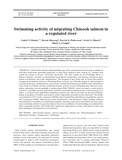Swimming activity of migrating Chinook salmon in a regulated river
Metadata
Show full item recordAuthor
Hasler, Caleb T.
Mossop, Brent
Patterson, David A.
Hinch, Scott G.
Cooke, Steve J.
Date
2012-10-17Citation
Hasler, Caleb T., Brent Mossop, David A. Patterson, Scott G. Hinch, and Steve J. Cooke. "Swimming activity of migrating Chinook salmon in a regulated river." Aquatic Biology 17 (2012): 47-56. DOI: https://doi.org/10.3354/ab00460.
Abstract
Adult Pacific salmon Oncorhynchus spp. have a fixed amount of energy available to
fuel their freshwater spawning migration, so they must optimize their activity in a manner that conserves energy to ensure successful spawning. The flow regime in the Puntledge River in British Columbia, Canada, is regulated for hydropower production, and this has resulted in alterations in discharge and water temperature. The purpose of this study was to assess the relative changes to locomotory activity in Puntledge River summer-run Chinook salmon O. tshawytscha at varying discharges, temperatures, and reaches. Coded electromyogram (EMG) radio transmitters were used to evaluate aerobic swimming-muscle activity of free-swimming fish. Because transmitter calibration was not possible, a standardized EMG (SEMG) value was used to relate relative activity to variability among individuals, reaches, encountered temperatures, and discharge variables. A random forest algorithmic modeling analysis was used to account for the non-independence of predictor variables and activity values repeatedly recorded on the same fish. The model accounted for 57.6% of the variance in SEMG and revealed that individuals accounted for most of the variation in SEMG, followed by reach, temperature, and discharge. These findings indicate that individual variability in swimming strategies, migratory behaviors, and habitat use may influence swimming activity to a greater degree than river conditions. If such findings are confirmed in other regulated systems, this would have important implications for how alterations in flow and their biological consequences are evaluated.

